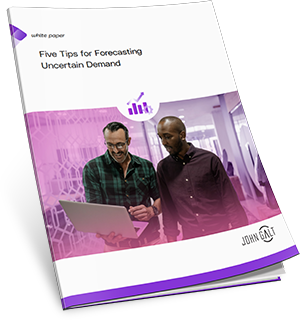When it comes to demand planning, a lot of attention is paid to forecasting — and for good reason. Before building out a demand plan, demand planners must first work closely with the sales and marketing teams to predict demand levels for each product and product line. It’s only then that they can take steps to efficiently fulfill customer orders while avoiding overstocking or stock-outs.
Given that, it’s important that the forecasts are as precise as possible. To that end, demand planners usually use a mix of qualitative and quantitative forecasting techniques to arrive at a final prediction. Read on to learn more about one of the most common ones demand planners use: time-series forecasting.
Let’s talk about what “time-series” means
To better understand what time-series forecasting is, let’s break things down a bit and focus on the “time-series” part. What does that refer to? Quite simply, it’s the use of time-series data in an analysis.
Demand planners look at a set of data points, such as the number of SKUs sold or the amount of revenue, and compare that over a period of time (which can be weeks, months, or years). They then use that historical data to make predictions about what will happen in the future over that same period of time.
Time-series forecasting techniques
There are a variety of ways demand planners can use time-series data in their forecasting. This data can also be weighted based on a variety of internal and external factors — which is where your demand planner’s judgment comes into play. Three common techniques include:
- Calculating your historical growth rate — This looks at what your sales were and what your growth rate was during a certain period of time and maps that over to a future time period of equal length.
- Looking at a moving average of your past sales — With this technique, you examine your average sales across a moving time frame (usually 3-5 months). This helps you monitor high and low periods of demand over time.
- Performing exponential smoothing — This practice assigns exponentially decreasing weights to older information. Therefore, recent information is weighted more heavily when predicting future events.
When to use time-series forecasting techniques
Time-series forecasting is a quantitative forecasting method. That is, the resulting forecasts are data-driven and focused only on the numbers. So these methods are ideal for arriving at a solid statistical baseline forecast, which may be enough if your product’s market isn’t vulnerable to a lot of volatility or if your product is in a mature stage of its market life cycle.
Download the white paper, Five Tips for Forecasting Uncertain Demand
 Effective demand forecasting is a demanding activity based on a branch of mathematics - statistics - that’s nonintuitive to most laymen. Gartner’s supply chain benchmarking research shows that best-in-class companies can achieve forecast accuracy of eighty percent or higher. Given that no forecast made without a crystal ball is ever perfect, eighty percent sounds very good...
Effective demand forecasting is a demanding activity based on a branch of mathematics - statistics - that’s nonintuitive to most laymen. Gartner’s supply chain benchmarking research shows that best-in-class companies can achieve forecast accuracy of eighty percent or higher. Given that no forecast made without a crystal ball is ever perfect, eighty percent sounds very good...
But if your industry is highly volatile and has a lot of demand variability, or if your product has a low forecastability, time-series forecasting serves only to provide a starting point. From there, you may need to use qualitative data to flesh out your prediction and arrive at a more accurate demand forecast.
It’s essential that every demand planner have a firm grasp on time-series forecasting. But the real challenge is being able to apply it well. That’s where having a software partner like John Galt comes in handy. We make it simple to gather the right data and crunch the numbers so that you can focus on actually applying the techniques to get the forecasts your company needs to move forward.


